#Calusa Indians
Text
In Search of the Calusa 3
In Search of the Calusa 3
About Randell Research Center, Pine Island, Lee County, FL -an extension of the University of Florida, both Ed and my alma-mater.
This post will be my final post in a series entitled “In search of the Calusa.” Today is number 3. You may have already read 1 & 2.
In Search of the Calusa 1
In Search of the Calusa 2
Pine Island’s Randell Reaserch Center was the perfect place to end Ed and my west…
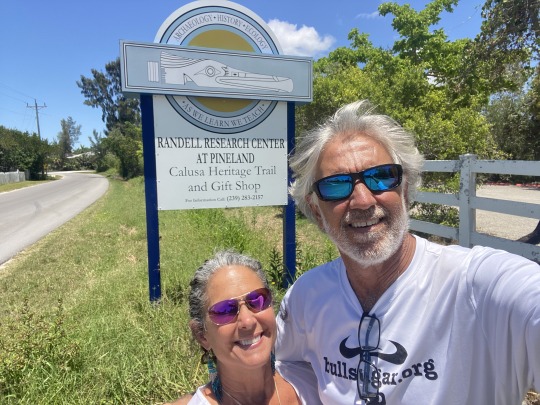
View On WordPress
#CALUSA#Calusa 3#Calusa Indians#Calusa shell mounds#History of the Calusa Indians#how do I learn about the Calusa#In Search of the Calusa 3#learning about the Calusa#Pine Island#Randell Reseach Center Pine Island#Randell Research Center
0 notes
Text
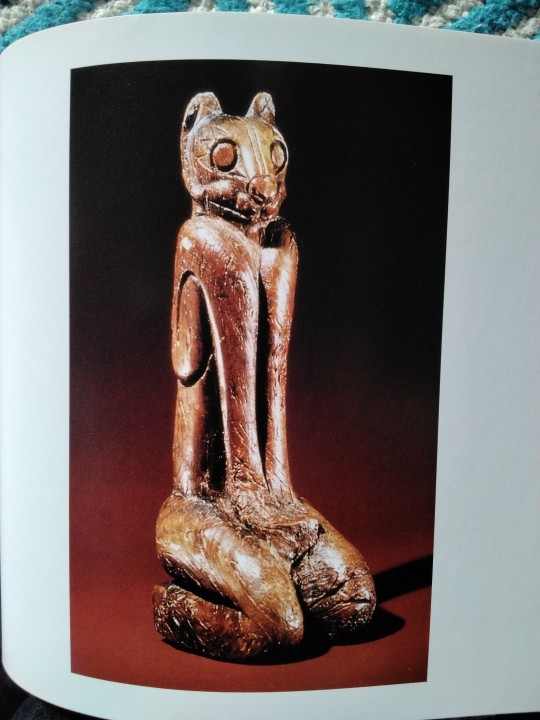
Key Marco cat, c.1600s.
Region: Florida.
This tribal representation of a kneeling cougar was part of an extraordinary archaeological find on Marco Island in 1896. This area of south-west Florida was originally populated by the Calusa Indians – hunter-gatherers who are known to have been fierce warriors. They fished in the estuaries and have been dubbed ‘The Shell People’ because of the great mounds of shells that have also been found here. They were scattered and disappeared soon after the Spanish explorers came to the area.
The Calusa were skilled artisans, and more than 1,000 pieces were discovered at the Key Marco site at the northern tip of the island, including masks and weapons, ceramics, bone and shell artefacts, some of which date back to the sixth century CE. The site was discovered by Captain W. D. Collier and excavated by Frank Hamilton Cushing. Dating from the seventeenth century, the cat is about 15cm (6 in) high and is in remarkably good condition. It is carved from wood and represents a feline/human figure. The anaerobic properties of the mud had preserved it for centuries.
Source: ‘Folk Art’, Susann Linn-Williams, pp. 154-55.
#Native American#traditional crafts#Marco Island#Florida#Calusa tribe#The Shell People#shells#Captain W D Collier#Frank Hamilton Cushing#folk art
3 notes
·
View notes
Text
Big Dawg Dumpsters Prices
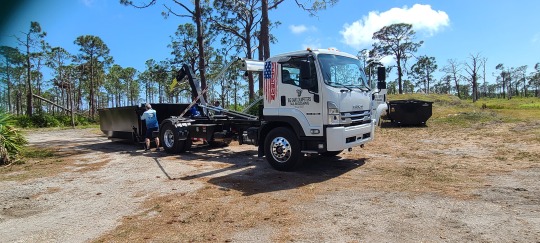
Tucked away in Charlotte County, Florida, is the unincorporated area of Port Charlotte, a vibrant and census-designated place renowned for its historic charm, natural allure, and hospitable environment. This recognition includes being named one of the “10 Best Places to Retire” in the United States by U.S. News & World Report in 2012.
The history of Port Charlotte dates back about 10,000 years to the Paleo-Indians, nomads who traversed the region during the last ice age, hunting large animals like woolly mammoths. Initially, Port Charlotte was not on the coast, as Florida's peninsula was much broader and drier.
With the end of the ice age, sea levels rose, shaping Florida’s present geography and climate. The Paleo-Indians were succeeded by the Calusa, the “shell people,” a thriving culture along the southwest Florida coast until the first Spanish explorers arrived in the 16th century. European contact led to the decline of the Calusa due to diseases like smallpox and measles, eventually making way for the Seminole people.
Florida transformed from a Spanish territory in 1819 to a U.S. state in 1845. Despite this, the Port Charlotte area remained largely underdeveloped for a century, mostly bypassing major transport routes and inhabited by a few cattle ranches and farms.
The post-World War II era marked a turning point, with the General Development Corporation, led by the Mackle brothers, capitalizing on the Florida land boom in the 1950s to develop areas including Port Charlotte. Despite significant growth, Port Charlotte retained its unincorporated status.
The community's resilience was tested by two major hurricanes. In 2004, Hurricane Charley, a Category 4 storm, struck near Charlotte Harbor, causing extensive damage. In 2022, Hurricane Ian, another Category 4 hurricane, inflicted significant destruction in the area.
Geographically, Port Charlotte’s location adds to its charm. Positioned at the north end of the Charlotte Harbor Estuary and close to Punta Gorda, it’s conveniently located between Tampa and Naples. Covering over 32 square miles, the area enjoys a warm, humid subtropical climate with hot summers and mild winters, contributing to an appealing temperature range year-round.
Port Charlotte represents more than a geographic location; it embodies a community enriched with historical depth, resilient spirit, and natural beauty. Its journey from ancient times to contemporary resilience highlights its status as an attractive and welcoming destination for both residents and retirees seeking the best of Florida living.
youtube
Featured Business:
Big Dawg Dumpsters LLC specializes in efficient waste management, allowing you to focus on your primary tasks. Our strong commitment to the quality and resilience of our dumpsters in Port Charlotte guarantees not just savings in time and effort but also provides a crucial tool for facilitating your garage cleanouts or managing major decluttering endeavors.
Contact:
Big Dawg Dumpsters LLC
17098 Marydale Rd, Port Charlotte, FL 33948, United States
XR8J+F3 Port Charlotte, Florida, USA
(743) 244–3294
26.93811040, -82.17401880
https://bigdawgfl.com/
Youtube Video:
https://www.youtube.com/watch?v=99xaizrDTx0
Youtube Playlist:
https://www.youtube.com/playlist?list=PLFLCke3VfXvPFpO7oHrQw1dlCEUTBntnh
Soundcloud:
https://soundcloud.com/big-dawg-dumpsters-llc/big-dawg-dumpsters-prices
Soundcloud Playlist:
https://soundcloud.com/big-dawg-dumpsters-llc/sets/big-dawg-dumpsters-prices
Medium Post:
https://medium.com/@bigdawgdumpstersllc/big-dawg-dumpsters-prices-1bfdaeb2473b
Weebly:
https://bigdawgdumpstersprices.weebly.com/
Tumblr:
https://bigdawgdumpsters.tumblr.com/post/737048372319551488/big-dawg-dumpsters-prices
Google MyMaps:
https://www.google.com/maps/d/viewer?mid=1ONoYwxxxcPKSP6c81TRpbDC-oC6GkHA
Google Maps CID:
https://www.google.com/maps?cid=17234576815232776912
Google Site:
https://sites.google.com/view/big-dawg-dumpsters-prices/
Twitter List:
https://twitter.com/i/lists/1736711169476526113
Twitter Tweets:
https://x.com/BigDawgDumpLLC/status/1736724006332760449
https://x.com/BigDawgDumpLLC/status/1736724467890761828
https://x.com/BigDawgDumpLLC/status/1736724618701046120
https://x.com/BigDawgDumpLLC/status/1736724764209942628
https://x.com/BigDawgDumpLLC/status/1736724174620795093
https://x.com/BigDawgDumpLLC/status/1736724966681547100
https://x.com/BigDawgDumpLLC/status/1736725106502828145
https://x.com/BigDawgDumpLLC/status/1736724329893957761
https://x.com/BigDawgDumpLLC/status/1736725247481843902
https://x.com/BigDawgDumpLLC/status/1736736657255399612
https://x.com/BigDawgDumpLLC/status/1736725405128864021
https://x.com/BigDawgDumpLLC/status/1736735397269704962
1 note
·
View note
Text
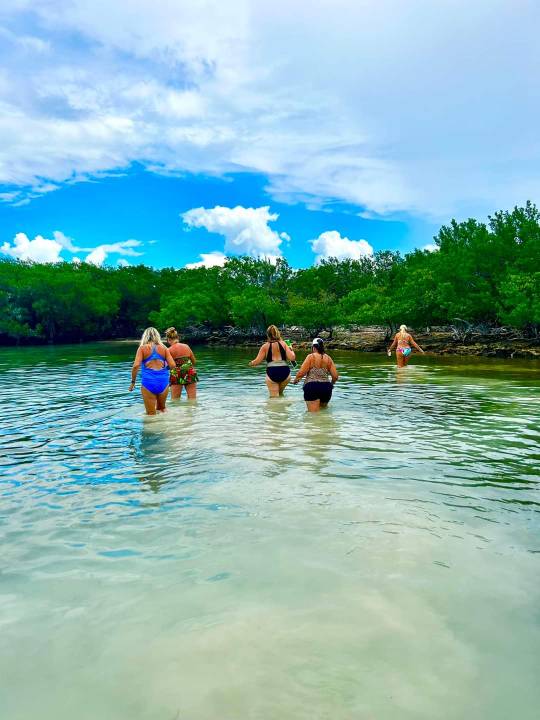
Wade up with Capt Rob and explore Indian Key. Abandoned in the 1840’s this tiny Island was once the 2nd wealthiest community in the United States. Ruins of the city still exist 200 years later. Just one stop of the day among many.
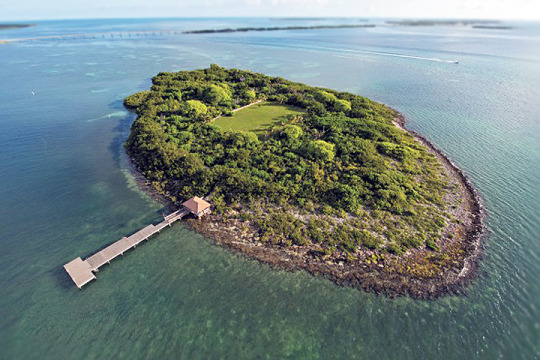
History
Native Americans began visiting and living on Indian Key around A.D. 800, and were likely a submissive tribe to either the Tequesta or Calusa chiefdoms, however, the exact nature of the relationship between the Keys Indians and these other groups has yet to be defined. Of interesting note is the fact that even in the 1840s and 50s, the Indians around the Keys were called "Spanish Speaking Indians" and not identified as Seminole of Miccosukee.
0 notes
Text
Downtown Fort Myers' "Allure Your Senses" Sculpture Analysis - Nestor Mendez

(The first sculpture is about 4 feet tall, with a width and length of 5 feet)
What you are looking at right here is one out of 23 wonderfully sculpted statues found in Downtown Fort Myers called "Allure Your Sense". The sculptor of this piece goes by the name of Edgardo Carmona, and they made their debut on January 7th, 2016. The initial motive for commissioning these works were for an exhibit. As the sculptures started to gain traction, the public soon wanted to keep them, and they were bought for $55,000 dollars to be a staple of Downtown Fort Myers.
This sculpture main purpose of this sculpture is to preserve the history of the Calusa Indians. Carmona treasures history, and he wanted to represent the struggles of the city in its initial stages. The community values these pieces of art because they are hot spots for socializing and can even spark a conversation. This sculpture resonates in the mind of many citizens because they are found in the same streets the amazing men like Thomas Edison and Henry Ford walked; in fact, this very same work of art can be found outside of the restaurant "Ford's Garage".

(The second is about 19ft tall, has a width and length of about 4ft including the base)
As you look at these next few pictures of two more sculptures from the "Allure Your Sense", you can really start to notice a pattern between them, and why the sculpture chose it to be this way. The surrounding area you see the rest of these sculptures and they are all performing some sort of act, or form of entertainment. Carmona's drive to preserve history led me to believe that the Calusa Indias where very optimistic and playful even in the mist of their situation. x

(The third sculpture is about 4ft tall, and was a width of about 6ft and a length of about 4ft)
0 notes
Text
16th Century Settlements - Florida Department of State
When European ships first landed on Florida in the 16th century, the area was well populated. Indians of the Timucua, Apalachee, Ais, Tekesta and Calusa were farming rich lands in the north -- growing corn, beans and squash -- and fishing or hunting for most of their food in the south.
0 notes
Text
Books by Clint Bennett: The Jesuit Warrior and Jason the Slave Warrior
Clint Bennett, Award-winning Author
A fourth-generation Floridian, whose family lived and thrived in the southern part of the Okefenokee swamp near Jasper, Florida, Clint Bennett was born in Dunedin, Florida and moved to Homosassa in 1976.
During four years in the U.S. Navy, he had the opportunity to tour the countries bordering the Mediterranean. Spain was one of his favorite ports of call. Up from the port was a Jesuit monastery, and Clint met and befriended several Spanish Jesuits, learning about their culture and history, especially the horrors of the Spanish Inquisition.
Three topics have always fascinated Clint: the horrendous suffering of the Europeans during the Inquisition, the impact the indigenous tribes of Florida by the arrival of Europeans, and the life and culture of the west Central Florida indigenous populations.
The Jesuit Warrior
After retiring from his professional writing job in 2000, Clint seriously researched and studied the Nature Coast area’s indigenous culture to begin creating his first novel, “The Jesuit Warrior,” a work of historical fiction that tells the story of a disillusioned Jesuit student living in Valencia, Spain during the Spanish Inquisition.
After witnessing a personal horror that causes him to question the teachings and agenda of the Jesuit priests, he boards a ship that will deliver slaves to central Florida. He is captured by the native people in Crystal River. Using his Jesuit medical training as an asset, he becomes a member of the Calusa village, eventually helping them survive attacks by the French and Spanish slavers.
Set in the Nature Coast, from Aripeka to Steinhatchee, including Crystal River and Homosassa, the novel is a wonderful work of historic fiction that grips the reader and teaches about the Calusa, the Timuc and the Appalachia Indian tribes that once thrived on west central Florida’s shores.
There are five-star reviews of his work on Amazon, Barnes and Nobel and other retailers.
Jason, The Slave Warrior
Next, Clint wrote, “Jason the Slave Warrior,” which begins in New Orleans, and is the story of a young slave and his wife who escape their masters during a hurricane. They steal a sailboat, heading for “a place in central Florida where the slavers are afraid to go.” The two make their way to crystal River, where they are welcomed into the Calusa tribe as honored members. Martha is a renown healer, and Jason a welcome translator and who becomes a valued warrior. The geographical setting for the book is primarily Crystal River, the Homosassa River, Steinhatchee north to Deckle – and south to Tampa, Florida. The Calusa, the Timuca, and the Appalachia Indian tribes and their culture are heavily described in this gripping historical fiction novel.
After ordering one, or both, of these novels, email Clint by clicking here to make arrangements for him to autograph your copy.
More About the Author, Clint Bennett
“I was born in Dunedin, Florida in 1945 and have fished and explored the waterways from Dunedin to Steinhatchee since I was old enough and strong enough to hold a paddle, a set of oars, or operate an outboard motor. I have canoed, camped, and explored most of the Suwannee River from the Okefenokee Swamp to Branford, Florida. Today I live in Crystal River, Florida with my wife and we continue to fish and explore the areas described in my books. I will gladly sign and personalize copies of my books,” Clint explains.
"During four years in the U.S. Navy, I had the opportunity of tour the countries bordering the Mediterranean Sea. Spain was one of my favorite ports of call. The squalid conditions in Spain during the early 18th century are accurate as described. My experiences in Europe helped to further my interest and research into the Spanish Inquisition and the numerous diseases and plagues that so devastated Europe for centires. I have also spent time in South Africa where I became interested in the horrors experience by the slaves and the savagery of their captors."
Read the full article
0 notes
Text
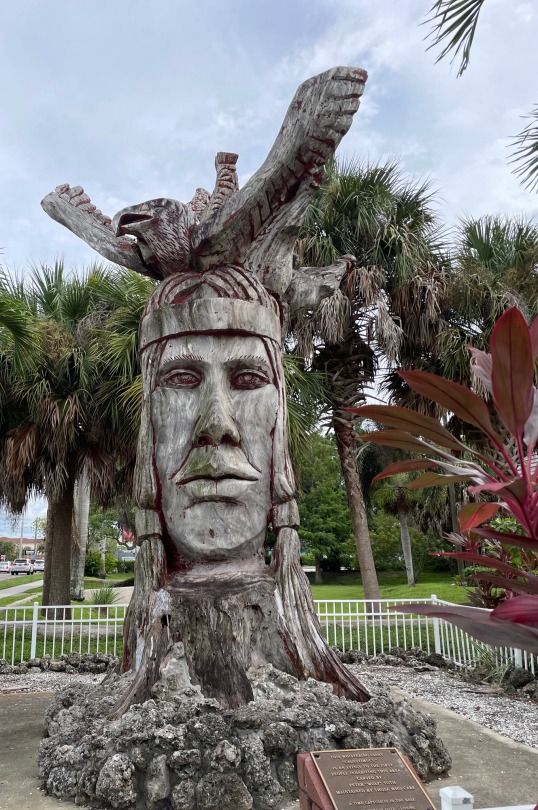
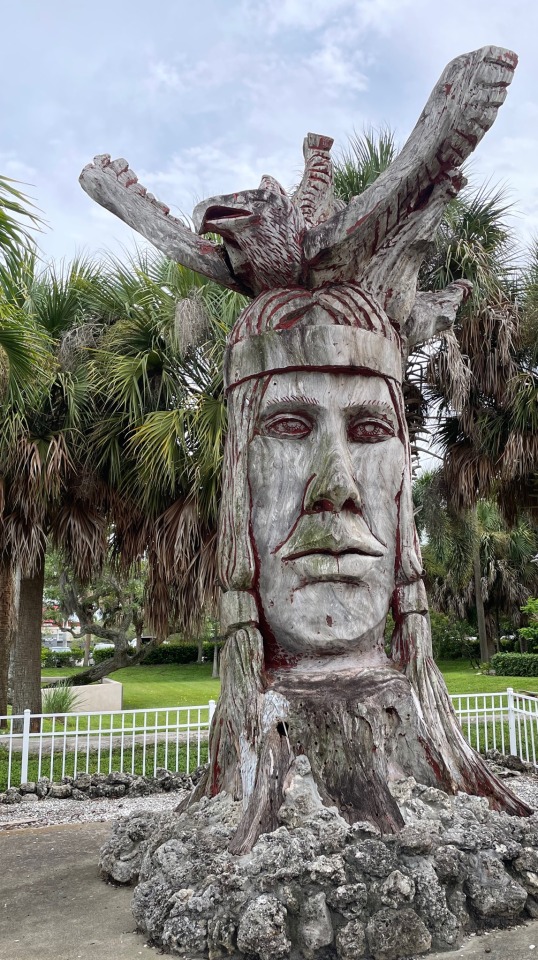
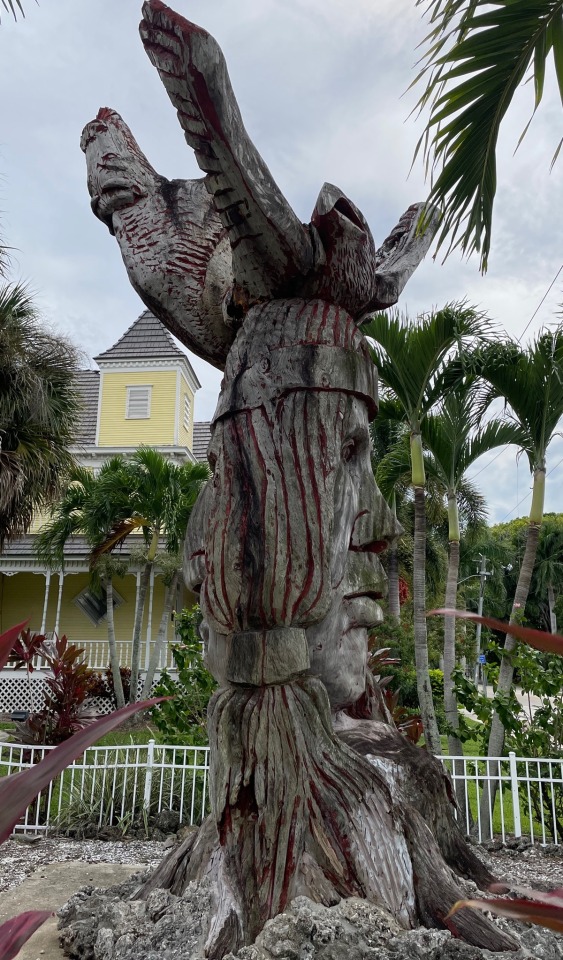
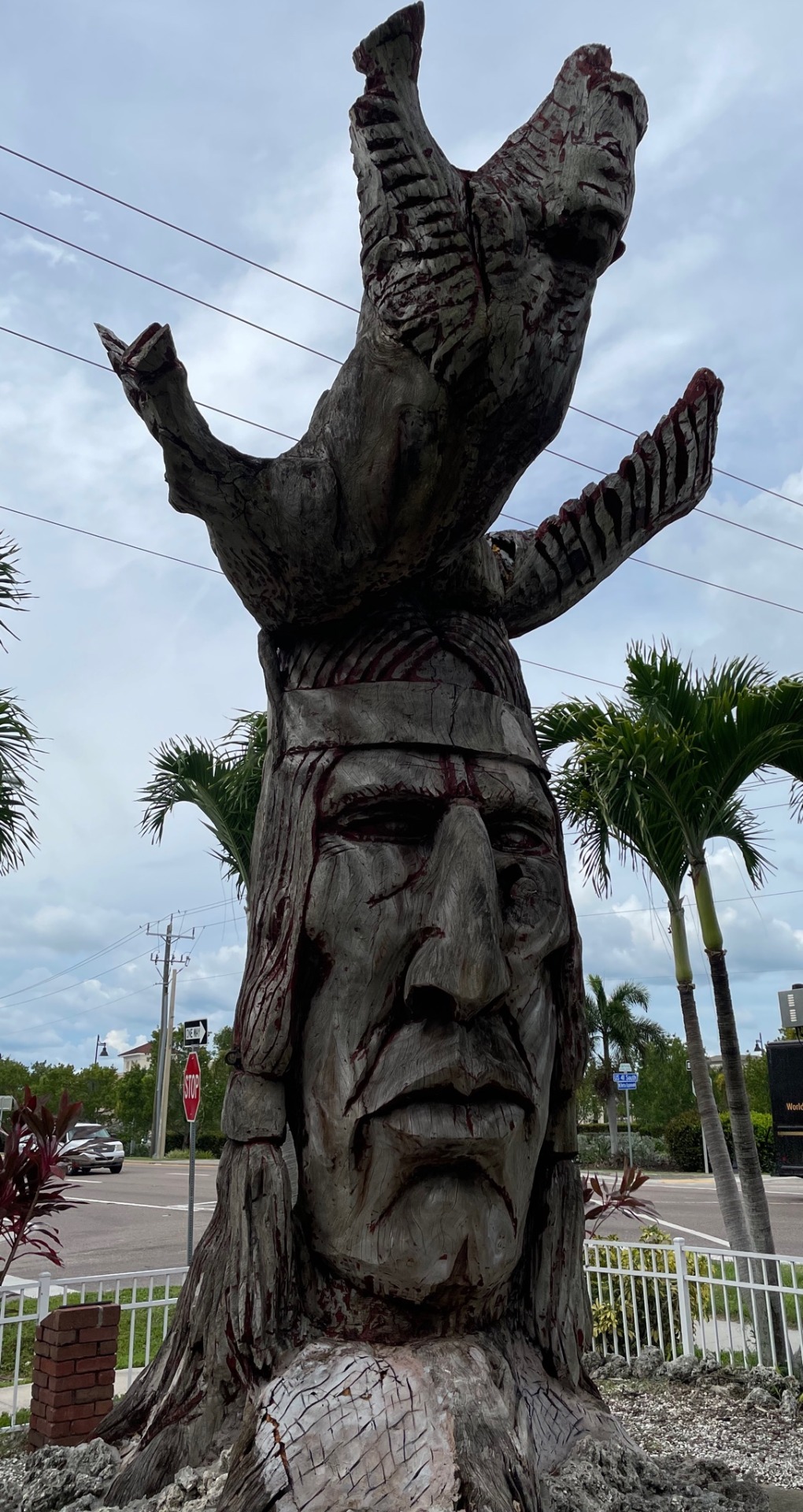
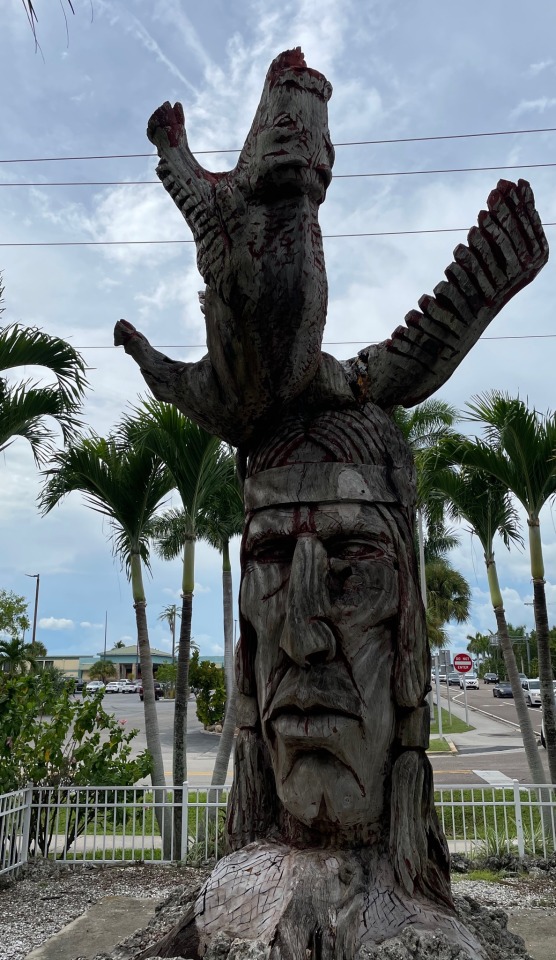
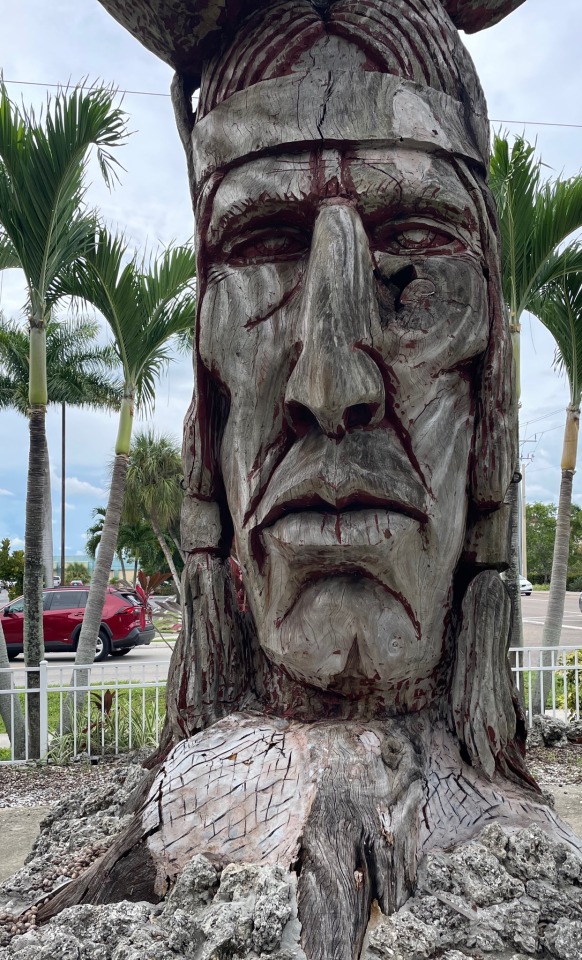

Calostimucu is a twenty-foot-tall statue carved in the round by Peter “Wolf” Toth. The fascinating story began in the seventies when Fred Babcock discovered a very large, dead monkey pod tree on his property overlooking the Charlotte Harbor in Southwest Florida. Fred Babcock had become aware of and impressed by, the sculpting talent of Peter “Wolf” Toth during a visit to La Jolla, California in 1972. La Jolla was the site where Toth had created his first massive sculpture of an Indian head. It was during his work on the cliff-carved stoned visage that he formulated his plan to shape a “Whispering Giant” Indian head in every state of the United States. Toth’s next stop was his “hometown” of Akron, Ohio where he elected to transition to sculpting in wood for the remainder of his series. Peter “Wolf” Toth was not born in Akron; his family fled Hungary in 1956 to escape Soviet occupation. Toth was captivated by the American Indians and sympathized with their mistreatment and oppression. He is quoted by Roadtrip America as explaining, “This (the statue) is my concept of the Indians of this area. I study the Indians of the area, then visualize an Indian within the log. It is a composite of all the native people of the state.” (Thurman 2010) Which perfectly mirrors what he achieved in Punta Gorda, FL.
Calostimucu is a composite of the Calusa and Timucua that were prevalent in this area prior to white expansion. Calostimucu is the tenth statue completed in Toth’s “Whispering Giant” campaign. It is unique in the dual nature of the round. It has two faces and two symbolic animals jutting from the crown. The face confronting all Southbound traffic on US 41 is that of a maiden. She looms, at twenty feet, stoic in the deep hewn lines bracketing her mouth with expressive deep-set eyes. She has a generous mouth situated above a squared jaw in an elongated face. Twin braids conceal her ears with an eagle positioned along the part in her hair. The eagle appears to be in distress: either falling from the sky or failing to gain flight. Opposite the maiden is the Chief. He strikes me as resigned in anger. The deep lines of his face and lips are emphasized by lingering red paint that has all but worn off the superficial exteriors of the monkey pod. I have attempted to capture what I found to be a compelling feature of the chief’s face. Toth chose to allow the natural grain of a burl to act as the undereye pad of Calostimucu’s male left eye. Knots in trees occur as branches are severed, or broken, from the living tree. The burl in the wood is a remnant of a lost limb, a scar, but also proof of the tree’s survival. I doubt that its inclusion was accidental. At the base of the figures are roots that Toth took pains to crosshatch, effectively concealing the wood’s grain. Juxtaposed on the opposed eye is a slash that draws further attention to the organic knot. The overall impression is of a man bruised and angry, calmly planning his next move. The animal form projecting from the Chief’s head is a buffalo. It is stationed on its back, clearly in distress, with four legs clawing at the sky. This corroborates the predicament of the eagle.
I grew up with this statue at the foot of Charlotte Harbor bridge. I remember waiting to see the Chief’s face as I crested the peak. I do not remember if I ever saw it covered in red paint. The reason that I chose this work is that it has always spoken to me. Whispering about rage and self-control. The property that Calostimucu originally stood on was severely damaged in Hurricane Charley. As the decision to relocate the statue was being considered in Charlotte County, there was a controversy concerning the composition of the figures that I had never considered. Citizens were disturbed by the buffalo’s anatomical correctness. I found the rank pettiness deeply offensive and had not been to visit my old friend since his face was turned away. I am extremely grateful to have had this incentive to revisit Calostimucu and am proud that it still remains. For me, Calostimucu epitomizes the community it resides in. Citizens appreciate the artistry and even some of the history. But they don’t want to look it full in the face. They prefer to turn away and pretend that something obvious, true, and essential isn’t there.
Thurman, G. (2010, October). Sculpture by peter wolf toth in winslow, arizona. Peter Toth sculpture in Winslow, Arizona. Retrieved September 17, 2022, from https://www.roadtripamerica.com/roadside/Peter-Wolf-Toth.htm
1 note
·
View note
Text
Journal 7 - Based on Field Trip 5 - Marine Studies Virtual Field Trip
Fort Myers Beach is a breathtaking Florida Beach. My colloquium class took a virtual field trip to Estero Island. I grew up in fort Myers. For most of my life, Fort Myers beach was a spot I frequently visited. The beach is quite beautiful and there are many different things to see. The houses and shops are all so colorful. Once you arrive at the beach, you'll be captivated by the breathtaking scenery.
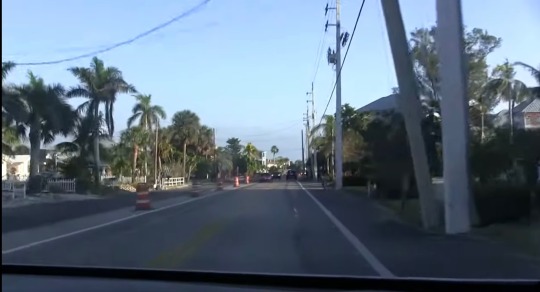
The tour was led by Mrs.Hughes, a long-time resident of the island and a member of the Estero Island Historic society. She told us stories of what it was like growing up on the island. I learned that the population when she was a child was only a few hundred and currently it is between six to seven thousand year around. Although during the winter its becomes 50-60 thousand.
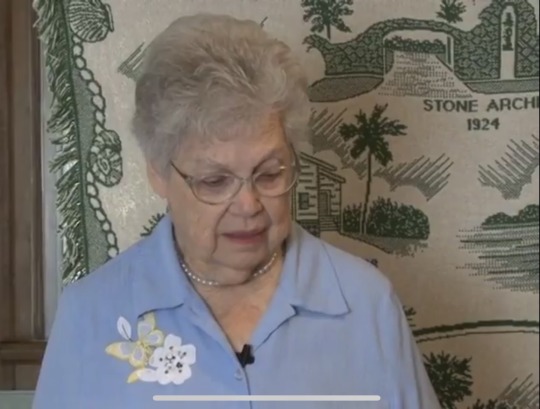
There were several original groups that settled in the area. Mrs. Hughes talked about the Calusa Indians and how they inhabited the island over 2,000 years ago. They constructed shell mounds along the bayside of the island. The Calusa met their demise when the Spanish came and took over. There was essentially a massacre that occured. The names Matanzas presevere and matanzas pass bridge come from that battle. Matanzas means massacre in Spanish. This is why you will see Spanish names all around the state due to the influence that they had.
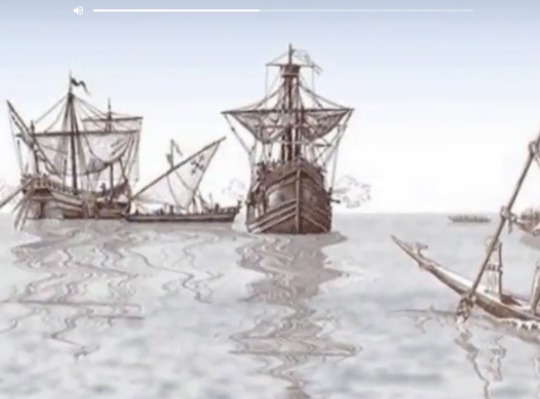
Fort myers beach was primarily a fishing village and it eventually transitioned into a tourist destination. We learned about the popular mullet fish. Many people used nets to catch these fish and would sell them to fish houses. Net fishing was eventually banned by the entire state and that's when the shift began. On top of that, their food source was taken away when the scallop's habitat was destroyed. Fort Myers beach has since begun to take proper steps to promote sustainability. Along with beach nourishment, a terminal groin was built on the south side of the Matanzas pass. The pass is a federally maintained channel that requires maintenance every three years Officials have taken the proper steps to have a healthy beach.
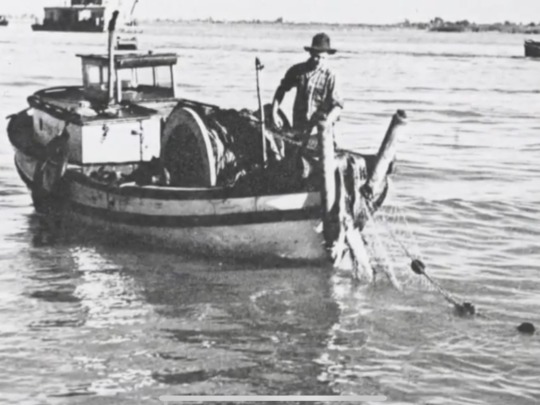
0 notes
Text
Wynwood Unearthed:
Calusa LGBT Indian Warrior Princess....
(Using Stand and /or Panel Wall mounted Options) 2022(c)
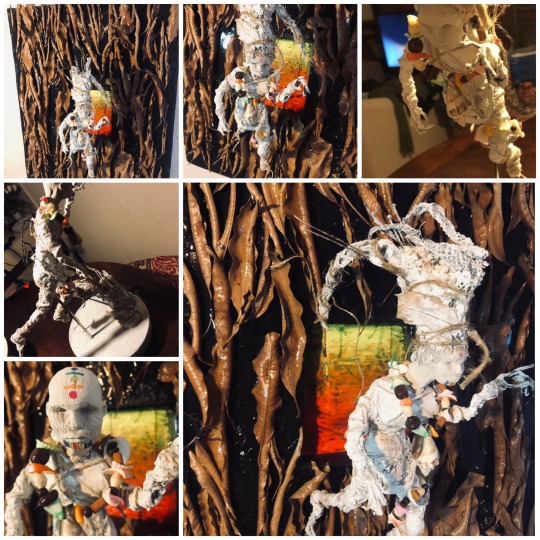
0 notes
Text
In Search of the Calusa 2
In Search of the Calusa 2
-Ed, Estero Bay, Lee County, FLIn Search of the Calusa 2-Mound Key to Marco Island, May 8-13, 2022.
In Calusa 1, Ed, Mindi, and I learned about villages of the Calusa that once existed right in downtown, Ft Meyers. Soon after, we visited an even more remarkable remnant, the Mound House seven miles away on Ft Meyers Beach.
Continuing our journey, we headed south along Estero Bay, an aquatic…
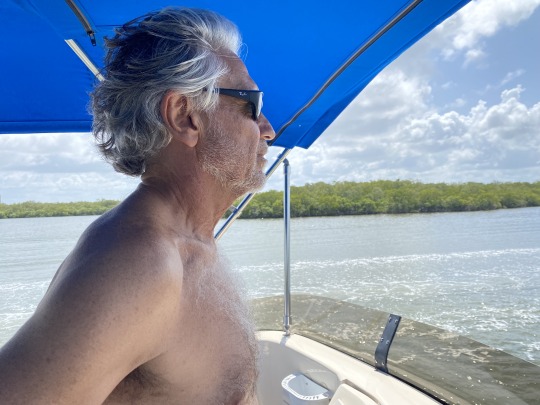
View On WordPress
#Archeological history Key Marco Cat#artifact replicas Calusa#Austin Bell#Calusa artifacts#Calusa culture#Calusa history made easy#Calusa Indians#Cushing#Estero Bay#Frank H. Cushing#In Search of the Calusa 2#Marco Cat#Marco Key#Mound Key#Mound Key Calusa#Mound Key capital#Old Marco Inn#Panther Man God#W.D. Captain Bill Collier#Wells M. Sawyer
0 notes
Text
Journal 7: Lovers Key State Park part 2
Next, we stopped at a beautiful opening in the trees where we were able to look across the bay and see one of the barrier islands. Here we discussed the three different types of mangroves, red which is closest to the water, black which is near the water, and white which is farthest away from the water.
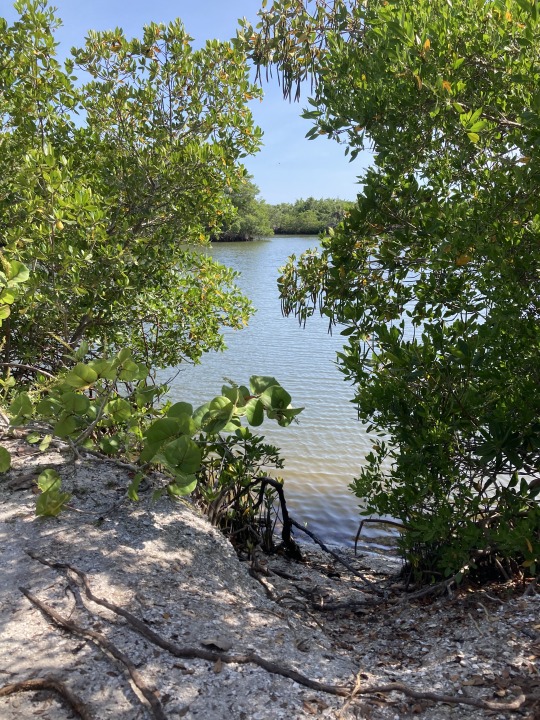
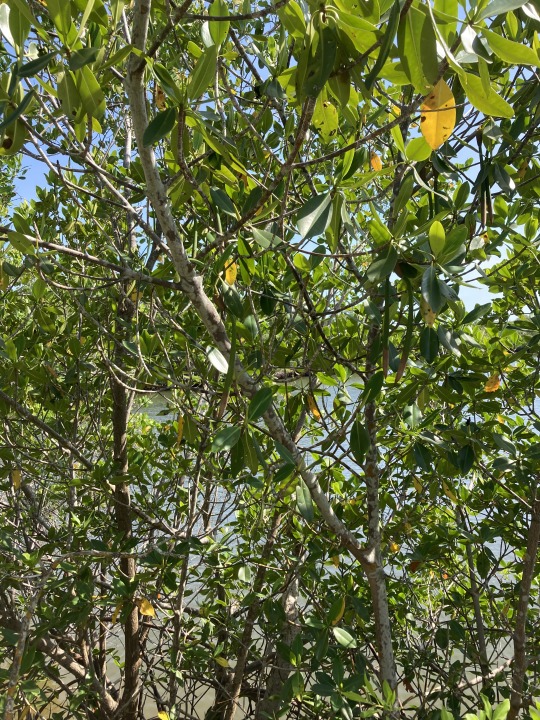
We learned that mangrove seeds known as propagules are actually part of the tree. This adaptation helps the tree grow rapidly upon falling into the soil. The propagules are green on the top half and brown on the lower half. The green part has a waxy texture allowing the plant to float in the water once it has fallen.
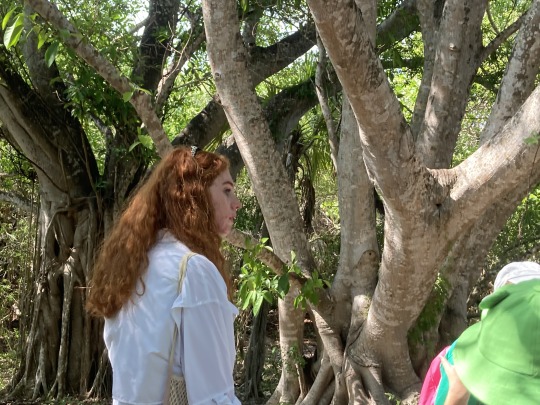
As we continued, we saw many strangler figs and banyan trees. Strangler figs lanch onto their host tree, however, will not kill the host tree because it will end up killing itself. Strangler figs need female wasps to pollinate them. This really shows how the trees are smart enough to use their host tree but not abuse the tree.

Here there was also a higher elevation and the trees created more of a shaded structure. We stood upon a replica of a shell mound called a midden. which is a trash heap. The Calusa Indians used to put shells and their trash in a midden making a large shell mound. These mounds were also very helpful to keep their villages from getting flooded.
3. Butterflies
At the butterfly garden, we learned that butterflies are pollinators and that all the plants presented in the garden were native to Florida.
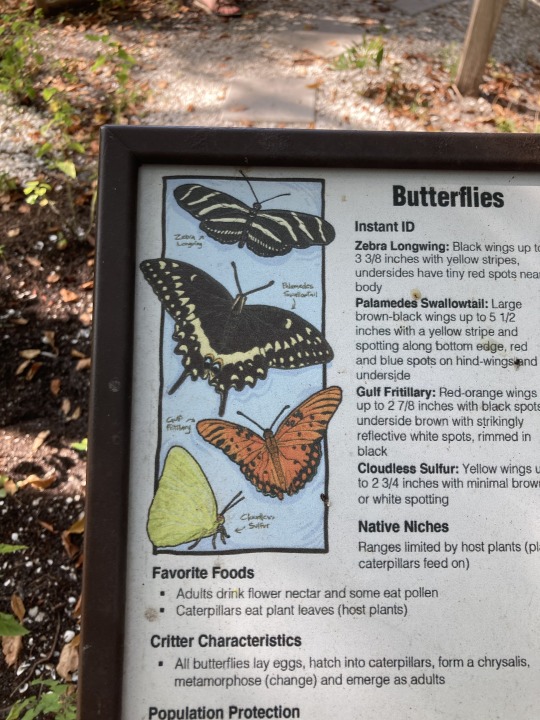
There were four types of butterflies present in the garden and there was this chart that gave us general information about the butterflies.

Zebra Longwing
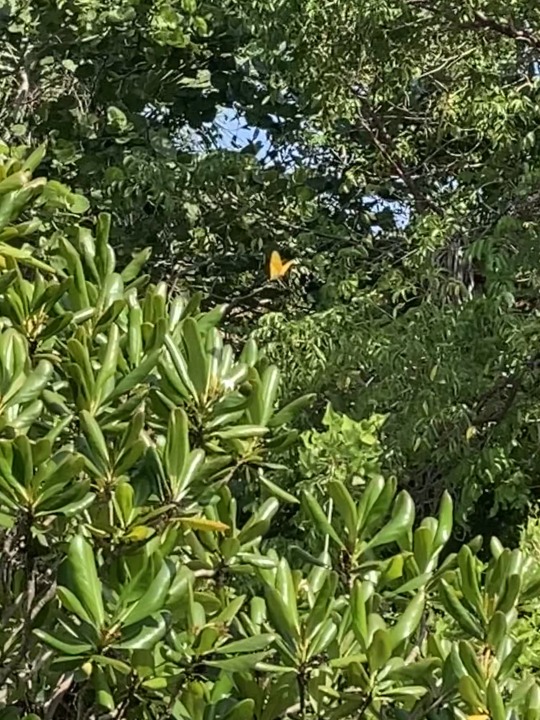
Gulf Fritillary
4. Walking along the beach
After reading the poem Walking along the beach I was not 100% on the message it was trying to convey. It started off with two people walking along the beach. And on their walk, their footprints in the sand that got washed away from the ocean reminded them of the good and bad times in their lives. They were connecting with the beach at this point, enjoying its characteristics. It mentioned how the crashing waves caught their attention and the tides fascinated them. It described the beautiful sights that surrounded them. They related the seagulls to scavengers and then said "Perhaps the outside forces, are similar as such," here I thought maybe they were connecting the problems the seagulls were facing to similar problems humans may face. It continues to say "as we walk we notice, the waves begin to cease" the seagulls, the wind, and their beauty is gone now in the poem. At first, I thought this last paragraph was explaining how as they walked they may have lost interest in the things that used to excite them. But as I reread I think that some time has passed and the ocean is losing its beauty due to pollution. That the seagulls are nowhere to be found, and the wind has died. Their steps begin to slow and they began to care. I think as a society we take so much advantage of the beauty and nature around us and forget to take care of it so it does not go away. We have been slowly killing off these ecosystems and not realizing that our impacts will make the extinct one day. I thought the poem overall was good, I'm just not the best at understanding their messages, but I don't feel that was the fault of the poem.
5. Shells
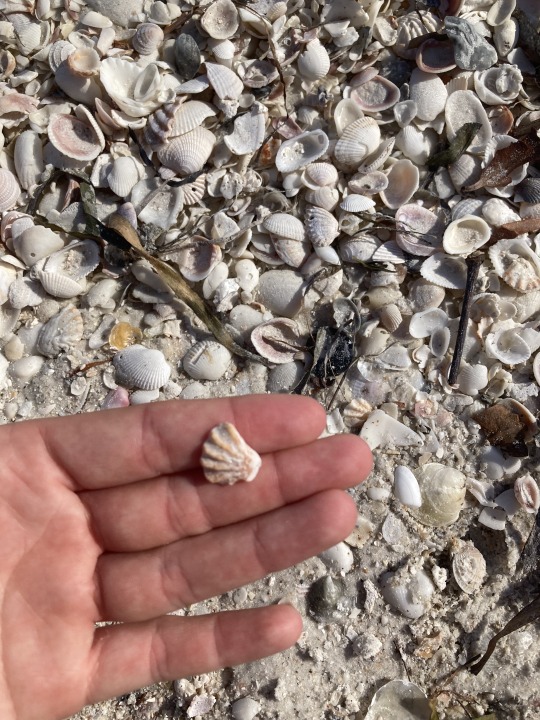
The Atlantic Kitten Paw
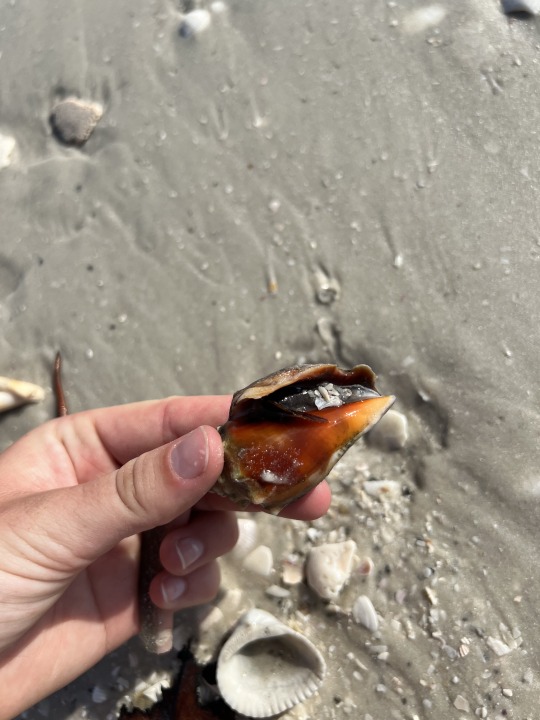
Florida Fighting Conch with mussel living inside
6. As we drove up the beach it was absolutely stunning. I have lived in Florida my whole life and sometimes forget to enjoy our wonderful weather and beaches. I also work at a marina and am surrounded by water and forget to appreciate the wildlife in the area.
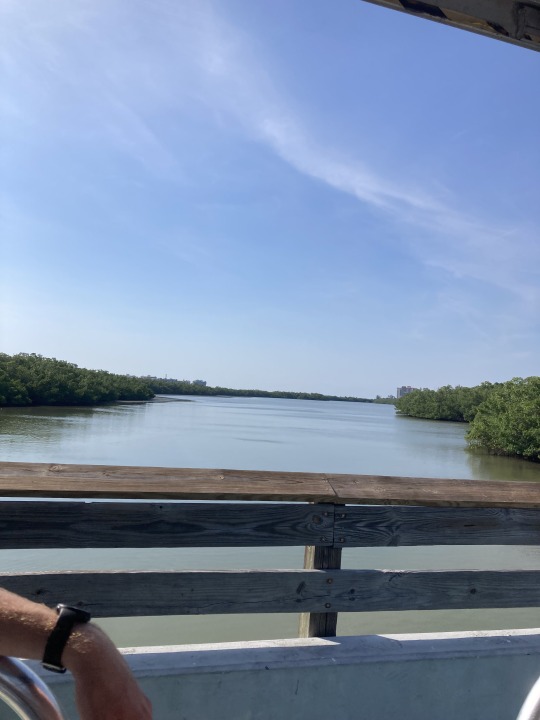
It was good to get outside and walk around, seeing the trees and wildlife. My favorite landscape is like the picture above with the sky fading from dark to light and the flat water acting as glass. I also find it very interesting how mangroves are able to sustain themselves in the water. Overall, I enjoyed our trip to Lover's Key as it reminded me to enjoy the beauty that surrounds us and to get outside more.
0 notes
Text
Big Dawg Dumpsters LLC

Welcome to the hidden gem of Charlotte County, Florida – Port Charlotte. This charming unincorporated community, designated as a census-designated place (CDP), captivates with its blend of historical allure, natural splendor, and an inviting ambiance. In 2012, Port Charlotte earned its place among the '10 Best Places to Retire' in the United States, as recognized by U.S. News & World Report.
Port Charlotte's roots delve deep into the annals of time, tracing back to the nomadic Paleo-Indians who roamed this land around 10,000 years ago during the waning years of the last ice age. These early settlers were driven by a pursuit of mammoth game as they trekked southward. Remarkably, Port Charlotte was not the coastal haven it is today; rather, Florida's peninsula stood broader and far drier than its contemporary form.
As the glaciers receded and sea levels surged, the landscape transformed, ushering in the era of the Calusa, renowned as the 'shell people.' Flourishing along the southwest Florida coast, the Calusa boasted a population exceeding 50,000 by the time Spanish explorers arrived in the 16th century.
Yet, the advent of European settlers introduced catastrophic diseases like smallpox and measles, decimating the once-thriving Calusa population. Eventually, the Seminole people migrated southward, establishing their presence on the Florida peninsula.
In 1819, the Spanish ceded Florida, turning it into a U.S. territory, and in 1845, the Sunshine State emerged as the 27th state of the Union. For the initial century of statehood, the vicinity encompassing Port Charlotte remained largely untamed and unexplored. Maps from the early 20th century illuminate the fact that most roads and railways leading into southwest Florida bypassed Port Charlotte. Save for a handful of cattle ranches and modest farming endeavors, the region remained a quiet, uninhabited frontier.
However, winds of change swept in with the post-World War II boom, igniting enthusiasm for land development across Florida. In the 1950s, the General Development Corporation (GDC), under the stewardship of the Mackle brothers, seized the moment amid the Florida land rush. GDC orchestrated land development projects along both of Florida's coastlines, including the picturesque Port Charlotte area. Consequently, Port Charlotte ascended to become the most populous community in Charlotte County, all while retaining its unincorporated status, a testament to GDC's distinctive approach.
Port Charlotte's mettle was tested by two significant hurricanes in its recent history. In August 2004, Hurricane Charley, initially projected as a Category 2 hurricane on a collision course with Tampa, executed a last-minute rightward shift, intensifying into a Category 4 tempest. It struck near Charlotte Harbor, causing extensive destruction in the city of Punta Gorda and the Port Charlotte vicinity. The storm's ferocious 145-mile-per-hour winds obliterated nearly half of the county's homes and inflicted substantial ecological damage upon sensitive wetlands.
Just over 18 years later, in September 2022, Port Charlotte grappled with the formidable Hurricane Ian, a Category 4 behemoth. Ian made landfall at Cayo Costa State Park before veering northeast into Charlotte Harbor, subjecting southeastern Port Charlotte to its unforgiving fury. Hurricane Ian left in its wake severe wind-related devastation across Port Charlotte and its environs, with a privately operated weather station in the vicinity recording maximum sustained winds of 115 miles per hour and a peak wind gust soaring to 132 miles per hour.
Port Charlotte's geographical allure also contributes to its magnetic appeal. Perched at the northern edge of the Charlotte Harbor Estuary, northwest of Punta Gorda, the community stands as a testament to nature's majesty. Positioned 100 miles south of Tampa and 65 miles north of Naples, Port Charlotte encompasses 32.3 square miles in total, with 28.4 square miles comprising land and an additional 3.9 square miles embracing water.
The climate here offers a warm humid subtropical experience, verging on a tropical wet and dry pattern. Summers unfurl with long, sultry days, frequently punctuated by rejuvenating afternoon thunderstorms. Winters bring a milder, warmer ambiance, coupled with notably diminished precipitation. Across all seasons, a diurnal temperature swing averaging around 20 degrees Fahrenheit promises a pleasant climate year-round.
Port Charlotte is more than a geographical location; it is a tapestry of rich history, unwavering resilience, and natural splendor. From its ancient Paleo-Indian origins to its modern challenges and triumphs, Port Charlotte remains an inviting haven, beckoning residents and retirees alike to savor a slice of Florida's finest.
youtube
Featured Business:
Discover your dependable ally in Port Charlotte, Florida's waste management needs – Big Dawg Dumpsters. With a commitment to efficiency and reliability, we provide a variety of dumpster sizes tailored to your unique requirements, all accompanied by swift same-day delivery. Our unwavering dedication to transparent pricing guarantees equitable rates for the highest quality service. Reach out to us today, and experience a seamless waste management solution, hassle-free.
Contacts:
Big Dawg Dumpsters LLC
17098 Marydale Rd, Port Charlotte, FL 33948, United States
XR8J+F3 Port Charlotte, Florida, USA
(743) 244–3294
https://bigdawgfl.com
Youtube Video:
https://www.youtube.com/watch?v=3gS1AlZeqHo
Youtube Playlist:
https://www.youtube.com/playlist?list=PLFLCke3VfXvMwHEqEKNd9d8zipVTmzS49
Soundcloud:
https://soundcloud.com/big-dawg-dumpsters-llc/big-dawg-dumpsters-llc
Soundcloud Playlist:
https://soundcloud.com/big-dawg-dumpsters-llc/sets/big-dawg-dumpsters-llc
Medium Post:
https://medium.com/@bigdawgdumpstersllc/big-dawg-dumpster-3cfa04ff37e4
Weebly:
https://bigdawgdumpsters-fl.weebly.com/
Tumblr Post:
https://bigdawgdumpsters.tumblr.com/post/735510350695383040/big-dawg-dumpsters
Google Map:
https://www.google.com/maps/d/u/0/viewer?mid=1DBreheEhOArV6102o9F_L16dyxOwjdI
Google Map CID:
https://www.google.com/maps?cid=17234576815232776912
Google Site:
https://sites.google.com/view/big-dawg-dumpsters-fl/
GBP Post:
https://big-dawg-dumpsters.business.site/posts/4058550361869564264
Twitter List:
https://twitter.com/i/lists/1730591969217531983
Twitter Tweets:
https://x.com/BigDawgDumpLLC/status/1730592143008563448
https://x.com/BigDawgDumpLLC/status/1730592824520069304
https://x.com/BigDawgDumpLLC/status/1730592980363608486
https://x.com/BigDawgDumpLLC/status/1730593127705313721
https://x.com/BigDawgDumpLLC/status/1730593273310519602
https://x.com/BigDawgDumpLLC/status/1730592503446032839
https://x.com/BigDawgDumpLLC/status/1730593724508606853
https://x.com/BigDawgDumpLLC/status/1730593878456324490
https://x.com/BigDawgDumpLLC/status/1734163666650739159
https://x.com/BigDawgDumpLLC/status/1730594037307257064
https://x.com/BigDawgDumpLLC/status/1730594168937078795
https://x.com/BigDawgDumpLLC/status/1730594320065904718
https://x.com/BigDawgDumpLLC/status/1730594463448518724
1 note
·
View note
Text
Pineland dig yields rare Calusa artifacts
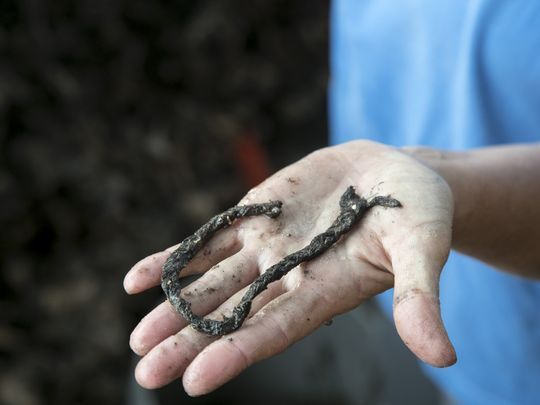
There's a reason you won't catch most local fishermen using anything but synthetic nets: Saltwater and subtropics are brutal on natural fiber, rotting it to frayed pulp in one scant season.
Which is what makes a bunch of newly filled zip-lock bags exciting to an archaeological team that's spent the last couple weeks painstakingly digging on Pine Island: They're full of thousand-year-old Calusa Indian rope, net and twine, among other finds.
No one has seen remnants of ancient daily life like this since the 1800s, when a Smithsonian expedition led by pioneering anthropologist Frank Hamilton Cushing unearthed more than 1,000 remarkably well-preserved artifacts, including the celebrated Key Marco cat near Marco Island. Read more.
82 notes
·
View notes
Photo




At the Calusa Mounds!
#calusa#indigenous#native american#american indian#midden#shell midden#pine island#florida#sacred#pre-columbian#gumbo limbo#Bursera simaruba#conch#really really old
2 notes
·
View notes
Photo
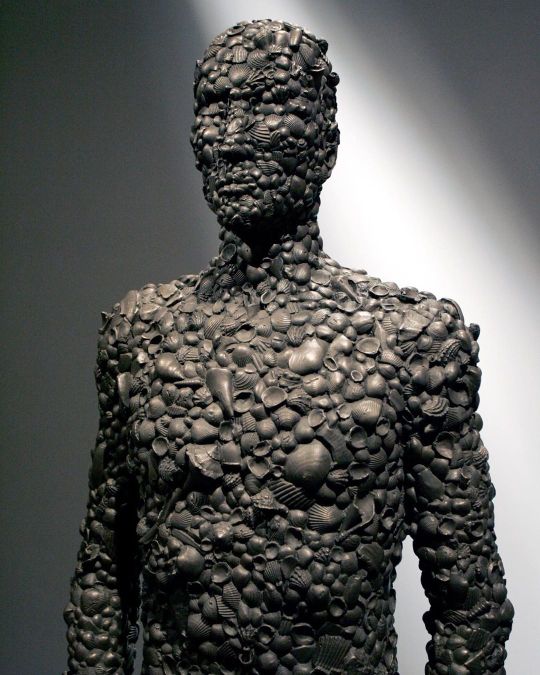
Throwback to Calusa from 2006. Bronze. Photos by Rudolf Van Dommele. The Calusa (sometimes referred to as “The Shell Indians”) were Native Americans that populated much of Florida. An eye opening wiki read. This piece was commissioned by Paul and Sue Kruder and made to remember these earlier inhabitants. It now stands at the heart of a small public park in Boca Grande, where I grew up. #sculpture #art #fineart #contemporaryart #calusa #florida #native #nativeamerican #gulfcost https://www.instagram.com/p/B-em1JglmiL/?igshid=9uinwoowfm4p
15 notes
·
View notes